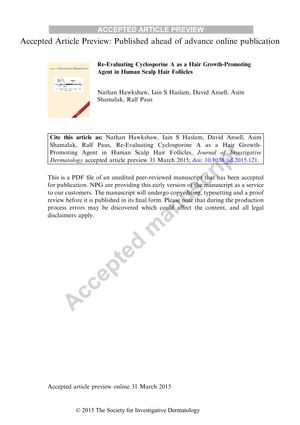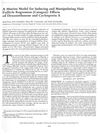Re-Evaluating Cyclosporine A as a Hair Growth–Promoting Agent in Human Scalp Hair Follicles
August 2015
in “Journal of Investigative Dermatology”

TLDR Cyclosporine A promotes hair growth and prolongs the active growth phase in human hair follicles, but may work differently than in rodents.
The study by Nathan Hawkshaw and colleagues from 2015 investigated the effects of Cyclosporine A (CSA) on human scalp hair follicles and found that CSA treatment for 6 days significantly increased hair shaft production and prolonged the anagen phase of the hair cycle. Histological analysis showed increased melanin, higher proliferation of hair matrix keratinocytes, and reduced fibroblast migration in the dermal papilla. The study also revealed that while NFATc1 was activated in human hair follicle stem cells, NFATc2 did not follow the same expression pattern as in rodents, indicating a potential difference in the mechanism of CSA's effects on human hair follicles. The study concluded that CSA inhibits the transition to the catagen phase in human hair follicles, but the underlying mechanisms may differ from those in rodents. The number of hair follicles tested varied from 6 to 43, pooled from multiple patients.
View this study on jidonline.org →
Cited in this study

research Cyclosporine A increases hair follicle growth by suppressing apoptosis-inducing factor nuclear translocation: a new mechanism
Cyclosporine A helps hair grow by blocking a process that would otherwise cause hair cells to die.

research Cyclosporin A-induced hair growth in mice is associated with inhibition of calcineurin-dependent activation of NFAT in follicular keratinocytes
Cyclosporin A helps mice grow hair by blocking a specific protein activity in skin cells.

research A Murine Model for Inducing and Manipulating Hair Follicle Regression (Catagen): Effects of Dexamethasone and Cyclosporin A
Dexamethasone speeds up hair loss in mice, while cyclosporin A slows it down.
Related

research Hair loss (alopecia or baldness)
Baldness is often hereditary and linked to male hormones, becoming noticeable when half the hair is lost.

research Treatments of hereditary hair loss (alopecia)
Some treatments like minoxidil, finasteride, and surgery can help with hereditary hair loss.

research Alopecia in adolescents-A survey
The document's conclusion cannot be provided because the document is not accessible or understandable.

research Towards a molecular understanding of hair loss and its treatment
Future hair loss treatments should aim to extend hair growth, reactivate resting follicles, reverse shrinkage, and possibly create new follicles, with gene therapy showing promise.

research Treatment of Hair Loss
Finasteride and minoxidil are effective for hair loss, but continued research is needed for better treatments.

research CLINICAL UPDATES IN HAIR
Most treatments for hair loss in 1997 were not effective for most people, and maintaining hair growth was difficult.

research Disorders of hair growth : diagnosis and treatment
Many hair loss conditions can be treated.